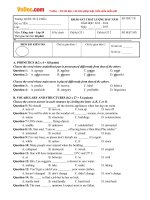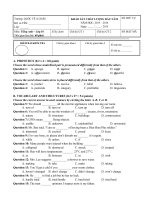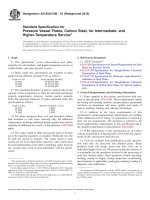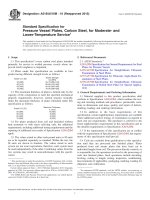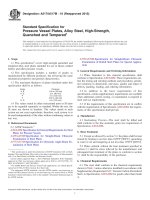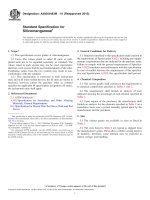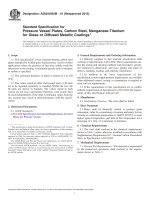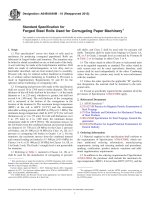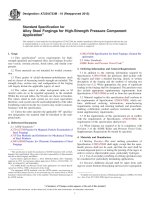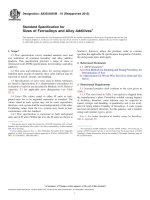Astm a 649 a 649m 10 (2015)
Bạn đang xem bản rút gọn của tài liệu. Xem và tải ngay bản đầy đủ của tài liệu tại đây (84.55 KB, 4 trang )
Designation: A649/A649M − 10 (Reapproved 2015)
Standard Specification for
Forged Steel Rolls Used for Corrugating Paper Machinery1
This standard is issued under the fixed designation A649/A649M; the number immediately following the designation indicates the year
of original adoption or, in the case of revision, the year of last revision. A number in parentheses indicates the year of last reapproval.
A superscript epsilon (´) indicates an editorial change since the last revision or reapproval.
1. Scope
1.1 This specification2 covers two kinds of rolls used in
machinery for producing corrugated paperboard. Rolls are
fabricated of forged bodies and trunnions. The trunnions may
be bolted or shrink assembled on one or both ends of the body.
A seal weld may be made at the body/trunnion interface. Roll
shells are made of carbon/manganese, or low alloy steel as
hereinafter described, and are heat treated prior to assembly.
Pressure rolls may be ordered surface hardened as Condition
H, or without surface hardening as Condition S. Provision is
made in Supplementary Requirements S1 and S3 for the
optional surface hardening of corrugating rolls.
1.2 Corrugating and pressure rolls made to this specification
shall not exceed 30 in. [760 mm] in inside diameter. The wall
thickness of the roll body shall not be less than 1⁄12 of the inside
diameter or 1 in. [25 mm], whichever is greater, but shall not
exceed 4 in. [100 mm]. The wall thickness of the corrugating
roll is measured at the bottom of the corrugations in the
location of the trunnion fit. The maximum design temperature
(MDT) of the roll is 600°F [315°C] and the maximum
allowable working pressure (MAWP) is 250 psi [1.7 MPa]. The
minimum design temperature shall be 40°F [4°C] for roll wall
thicknesses up to 3 in. [75 mm]. For roll wall thicknesses over
3 in. [75 mm] to 4 in. [100 mm], the minimum design
temperature shall be 120°F [50°C]. The maximum stresses on
the roll bodies from the combined internal and external loading
are limited to 18 750 psi [129 MPa] for the Class 2 pressure
roll bodies, and 20 000 psi [138 MPa] for Class 1A, 1B, or 5
pressure or corrugating roll bodies in Grades 1 or 2. For the
trunnions, the maximum stresses from the combined internal
and external loading are limited to 15 000 psi [103.4 MPa] for
Classes 3 or 4, or 20 000 psi [138 MPa] for Classes 1A, 1B, or
5 in Grade 2 only. The Grade 1 strength level is not permissible
for trunnions.
1.3 Referring to Table 1, material to Classes 1A, 1B, or 5
shall be used for the manufacture of corrugating or pressure
roll shells, and Class 2 shall be used only for pressure roll
shells. Trunnions shall be made from forgings in Classes 1A,
1B, or 5 in Grade 2 strength level as restricted by Footnote B
in Table 2 or in forgings in either Class 3 or 4.
1.4 The values stated in either SI units or inch-pound units
are to be regarded separately as standard. The values stated in
each system may not be exact equivalents; therefore, each
system shall be used independently of the other. Combining
values from the two systems may result in non-conformance
with the standard.
1.5 Unless the order specifies the applicable “M” specification designation, the material shall be furnished to the inchpound units.
1.6 Except as specifically required in this standard, all of the
provisions of Specification A788/A788M apply.
2. Referenced Documents
2.1 ASTM Standards:3
A275/A275M Practice for Magnetic Particle Examination of
Steel Forgings
A370 Test Methods and Definitions for Mechanical Testing
of Steel Products
A788/A788M Specification for Steel Forgings, General Requirements
E165/E165M Practice for Liquid Penetrant Examination for
General Industry
3. Ordering Information
3.1 Material supplied to this specification shall conform to
the requirements of Specification A788/A788M, which outlines additional ordering information, manufacturing
requirements, testing and retesting methods and procedures,
marking, certification, product analysis variations and additional supplementary requirements.
3.2 In addition to the ordering requirementsof Specification
A788/A788M, the purchaser shall include the maximum design temperature (MDT), if lower than 600°F [315°C], and the
1
This specification is under the jurisdiction of ASTM Committee A01 on Steel,
Stainless Steel and Related Alloys and is the direct responsibility of Subcommittee
A01.06 on Steel Forgings and Billets.
Current edition approved March 1, 2015. Published March 2015. Originally
approved in 1971. Last previous edition approved in 2010 as A649/A649M – 10.
DOI: 10.1520/A0649_A0649M-10R15.
2
For ASME Boiler and Pressure Vessel Code applications see related Specification SA-649/SA-649M in Section II of that Code.
3
For referenced ASTM standards, visit the ASTM website, www.astm.org, or
contact ASTM Customer Service at For Annual Book of ASTM
Standards volume information, refer to the standard’s Document Summary page on
the ASTM website.
Copyright © ASTM International, 100 Barr Harbor Drive, PO Box C700, West Conshohocken, PA 19428-2959. United States
1
A649/A649M − 10 (2015)
TABLE 1 Chemical Requirements
Composition, %
Carbon
Manganese
Phosphorus
Sulfur
SiliconA
Nickel
Chromium
Molybdenum
A
Class 1A
Class 1B
Class 2
Class 3
Class 4
Class 5
0.45–0.60
0.55–1.05
0.025 max
0.025 max
0.15–0.35
...
0.80–1.15
0.15–0.50
0.40–0.60
0.60–0.95
0.025 max
0.025 max
0.15–0.35
1.55–2.00
0.65–0.95
0.20–0.45
0.55 max
0.50–0.90
0.025 max
0.025 max
0.15–0.35 max
...
...
...
0.35 max
0.40–0.70
0.025 max
0.025 max
0.15–0.35
...
0.80–1.15
0.15–0.25
0.35 max
0.60–1.05
0.025 max
0.025 max
0.15–0.35 max
...
...
...
0.50–0.60
0.90–1.50
0.025 max
0.025 max
0.15–0.35
0.60 max
0.30 max
0.15 max
When vacuum carbon deoxidation (VCD) is used the silicon content shall be 0.10 % maximum.
TABLE 2 Tensile Requirements
Class
1A, 1B or 5
1A, 1B or 5
2
3 or 4
A
B
Grade
1
2B
...
...
Yield Strength, minA
Tensile Strength, min
ksi
[MPa]
ksi
[MPa]
130
65
37.5
30
[890]
[450]
[260]
[205]
150
100
75
60
[1030]
[690]
[515]
[415]
Elongation in 2 in.
or 50 mm, %, min
Reduction of
Area, %, min
12.0
14.0
20.0
22.0
30
30
50.0
55
0.2 % offset.
For trunnion application, a maximum tensile strength of 125 ksi [860 MPa] applies for Grade 2 of Classes 1A, 1B, or 5.
requirements are specified, a normalize and temper heat
treatment may be applied.
4.2.1.3 The trunnions shall be normalized and tempered or
annealed to produce the required mechanical properties.
4.2.2 Surface Hardening of Pressure Roll Forgings—For
Condition H the working face of pressure rolls shall be surface
hardened either before or after fitting the trunnions, at the
manufacturer’s option. Surface hardening by weld overlays is
not permitted for Condition H or (subsequently) for Condition
S.
maximum allowable working pressure (MAWP), if lower than
250 psi [1.7 MPa] as allowed in 1.2 of the Scope.
3.3 When ordering pressure rolls the purchaser shall stipulate the required condition, either surface hardened (Condition
H) or as heat treated (Condition S). In the event that the
condition is not specified the default condition is H.
3.4 If a corrugating roll is required to be surface hardened
by the forging supplier, prior to forming the flutes by the
purchaser, the requirements of Supplementary requirement S1
shall apply.
4.3 Assembly and Weld—Except for integrally forged or
bolted-on trunnions, the assembly shall be made by shrink
fitting trunnions into the prepared body ends. If used, welding
of the trunnion to the roll body is restricted to a 3⁄8 in. [9.5 mm]
max. seal weld, made with low hydrogen materials. A minimum preheat of 400°F [205°C] and a minimum post weld heat
treatment of 850°F [455°C] for 8 h shall be used. The
maximum post weld heat treatment shall be not higher than t −
50°F [t − 28°C] where t is the final tempering temperature. All
welds shall be machined or ground for the final magnetic
particle or liquid penetrant examination.
3.5 If the requirements of this specification are in conflict
with the requirements of Specification A788/A788M, then the
requirements of this specification shall prevail.
4. Materials and Manufacture
4.1 Forging Process:
4.1.1 Roll body forgings may be made as solid forgings and
subsequently bored.
4.1.2 Trunnions or gudgeons which are to be subsequently
assembled to form the roll shall be made as a solid forging or
where practical upset from segments cut from billets or bars.
4.2 Heat Treatment:
4.2.1 Heat Treatment for Mechanical Properties (Requirements do not apply to surface treatment):
4.2.1.1 Machining—The forged roll body shall have all
surfaces rough machined, including boring, prior to heat
treatment for mechanical properties and be tested in accordance with 6.1.2.1. The manufacturer may opt to bore after
heat treatment for mechanical properties instead provided the
forging is tested in accordance with 6.1.2.2.
4.2.1.2 Roll bodies shall be normalized, liquid quenched,
and tempered to produce the required mechanical properties,
except that for Class 2 forgings, and when Grade 2 strength
5. Chemical Composition
5.1 The steel shall conform to the requirements for chemical
composition prescribed in Table 1.
6. Mechanical Properties
6.1 Tensile Requirements:
6.1.1 The material shall conform to the requirements for
tensile properties prescribed in Table 2 when tested in accordance with Test Methods and Definitions A370. Tension test
specimens shall be the standard round 1⁄2-in. [12.5 mm]
2
A649/A649M − 10 (2015)
8. Magnetic Particle Examination
diameter, 2-in. [50 mm] gage length. The yield strength
prescribed in Table 2 shall be determined by the 0.2 % offset
method.
6.1.1.1 Tests for acceptance shall be made after the heat
treatment of the forgings, for mechanical properties in accordance with 4.2.1.
6.1.2 Number, Location, and Orientation of Test Specimens:
6.1.2.1 Roll Body Forgings—A full-size prolongation shall
be provided on a roll body forging representing each heat of
steel in each heat-treatment furnace charge. One longitudinal
tension test specimen shall be taken from the prolongation and
the axis of the specimen shall be located midway between the
inner and outer surfaces of the wall body.
6.1.2.2 If bored after heat treatment per 4.2.1.1, the central
long axis of the longitudinal test specimen shall be located at
the inside diameter of the bore dimension, with the specimen
mid-length located at a minimum of T from the end face, where
T is the original heat-treated outer diameter of the solid
forging.
6.1.2.3 Trunnions—Test material shall be provided from
each heat of steel in each heat-treatment furnace charge. One
longitudinal tension specimen shall be taken from each test
piece and the axis of the specimen shall be located at any point
midway between the center and surface of the solid forging.
8.1 The entire surface of the roll, including the seal weld
area, shall be examined by either a wet continuous method in
accordance with Practice A275/A275M or by a liquid penetrant
method in accordance with Practice E165/E165M after machining or grinding. The use of prods in the magnetic particle
method is not permitted.
8.2 Only indications with major dimensions greater than 1⁄8
in. [3.2 mm] are considered relevant.
8.3 Acceptance Standards—The following relevant indications are unacceptable:
8.3.1 Any linear indications greater than 3⁄16 in. [4.8 mm]
long.
8.3.2 Rounded indications greater than 3⁄16 in. [4.8 mm].
8.3.3 Four or more indications in a line separated by 1⁄16 in.
[1.6 mm] or less edge to edge.
8.3.4 Ten or more indications in any 6 in.2 [38.71 cm2] of
surface.
9. Hydrostatic Testing
9.1 The machined roll assembly shall be hydrostatic tested
at 11⁄2 times the maximum allowable working pressure
(MAWP). The MAWP pressure shall be furnished by the
purchaser.
6.2 Hardness:
6.2.1 Roll body forgings shall have a Brinell hardness from
352 HB to 415 HB (Grade 1) or 207 HB to 285 HB (Grade 2).
No less than three hardness determinations shall be made on
each roll. After completion of heat treatment described in 4.2,
the hardness readings are to be taken on the outside of the roll
bodies using care to prepare locations for tests that are free of
decarburization but not so deep as to affect the usefulness of
the material.
6.2.2 The surface hardened pressure roll body forgings in
Condition H shall have a hardness of 58 to 65 HRC or
equivalent. No less than three hardness determinations shall be
made on each roll. The hardness depth shall not exceed 1⁄4 in.
[6 mm].
9.2 The recommended minimum hydrostatic test temperature is 70°F [21°C].
10. Marking, Packaging, and Loading
10.1 In addition to the marking requirements of Specification A788/A788M, the MDT and the MAWP shall be included
together with any required application code marking.
10.2 Packaging and loading shall be done so that the forging
is not damaged during shipment to the purchaser.
10.3 For pressure roll forgings the marking and certification
shall include the applicable condition letter, H or S.
11. Keywords
7. Retreatment
11.1 internal pressure; laser hardened; machinery—
corrugating; roll assembly—forged; rolls—corrugating; rolls—
pressure; steel forgings—alloy; steel forgings—carbon; steel
rolls; surface-hardened; trunnions—bolted; trunnions—shrinkfitted
7.1 If the results of the mechanical tests of any forging do
not conform to the specified requirements, the manufacturer
may retreat the forging one or more times, but not more than
three additional times without approval of the purchaser.
3
A649/A649M − 10 (2015)
SUPPLEMENTARY REQUIREMENTS
The following supplementary requirements shall apply only when specified by the purchaser on the
order and agreed to by the manufacturer:
S2.1.2 Minimum value for absorbed energy or lateral expansion.
S2.1.3 Test temperature.
S2.1.4 Frequency of testing.
S2.2 Trunnion and pressure rolls may be liquid quenched
and tempered instead of the heat treatments specified in 4.2
when impact testing is required.
S1. Surface-Hardened Corrugating Rolls
S1.1 After all surfaces have been machined, the outer
surface of the corrugating rolls may be surface-hardened to a
surface hardness of Rockwell 53 HRC to 65 HRC. The depth
of hardness shall not exceed 3⁄8 in. [9.5 mm]. A minimum of
three hardness determinations shall be made on the surface.
Additional hardness tests shall be made to establish the depth
of hardness. The hardened surface shall be magnetic particle
tested (see Section 8).
S3. Laser Hardened Flute Tips
S2. Notch Toughness
S3.1 After the flute profile of corrugating rolls has been
formed, the flute tips shall be laser hardened to a surface
hardness of 53 to 65 HRC. The dimensions of the hardened
profile shall be as agreed between purchaser and supplier.
S3.2 The hardened surfaces shall be examined by the
magnetic particle method in accordance with Section 8.
S2.1 For applications where minimum notch toughness
limits are required, impact testing shall be specified for both
roll bodies and trunnions. The following requirements shall be
specified:
S2.1.1 Type of impact specimen and test standard (for
example, Test Methods and Definitions A370 specimen Type A
or B).
ASTM International takes no position respecting the validity of any patent rights asserted in connection with any item mentioned
in this standard. Users of this standard are expressly advised that determination of the validity of any such patent rights, and the risk
of infringement of such rights, are entirely their own responsibility.
This standard is subject to revision at any time by the responsible technical committee and must be reviewed every five years and
if not revised, either reapproved or withdrawn. Your comments are invited either for revision of this standard or for additional standards
and should be addressed to ASTM International Headquarters. Your comments will receive careful consideration at a meeting of the
responsible technical committee, which you may attend. If you feel that your comments have not received a fair hearing you should
make your views known to the ASTM Committee on Standards, at the address shown below.
This standard is copyrighted by ASTM International, 100 Barr Harbor Drive, PO Box C700, West Conshohocken, PA 19428-2959,
United States. Individual reprints (single or multiple copies) of this standard may be obtained by contacting ASTM at the above
address or at 610-832-9585 (phone), 610-832-9555 (fax), or (e-mail); or through the ASTM website
(www.astm.org). Permission rights to photocopy the standard may also be secured from the Copyright Clearance Center, 222
Rosewood Drive, Danvers, MA 01923, Tel: (978) 646-2600; />
4
